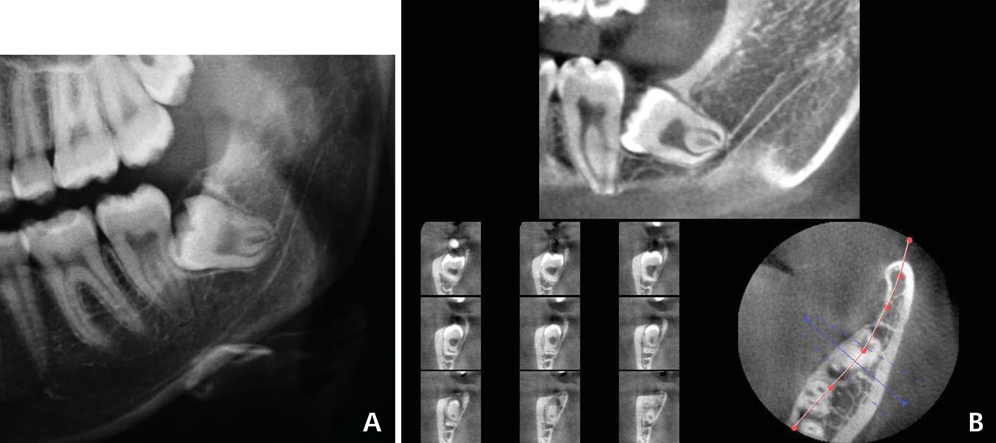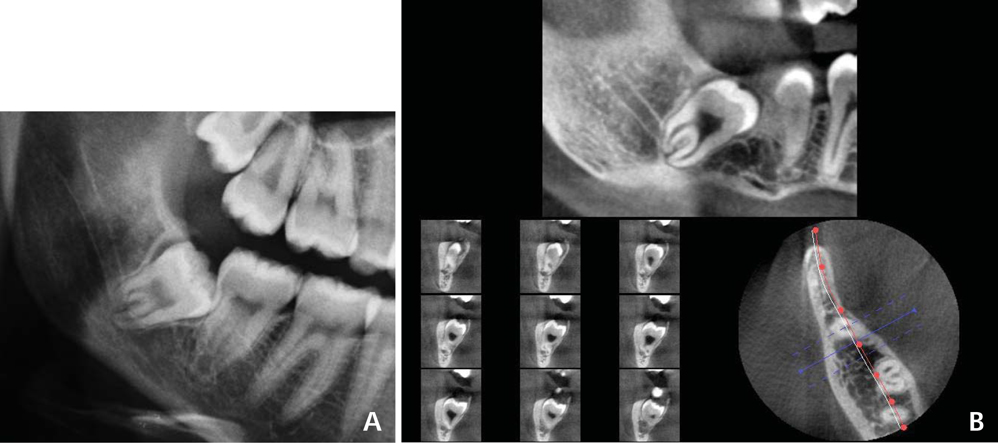Imaging Sci Dent.
2013 Jun;43(2):105-109. 10.5624/isd.2013.43.2.105.
Comparison of panoramic radiography with cone beam CT in predicting the relationship of the mandibular third molar roots to the alveolar canal
- Affiliations
-
- 1Biomaterial Research Center, Department of Oral and Maxillofacial Radiology, School of Dentistry, Shiraz University of Medical Sciences, Shiraz, Iran.
- 2Department of Oral and Maxillofacial Surgery, School of Dentistry, Shiraz University of Medical Sciences, Shiraz, Iran.
- 3Department of Oral and Maxillofacial Radiology, School of Dentistry, Shiraz University of Medical Sciences, Shiraz, Iran. pegah_brix@yahoo.com
- KMID: 1974437
- DOI: http://doi.org/10.5624/isd.2013.43.2.105
Abstract
- PURPOSE
Preoperative radiographic assessment of the mandibular third molars is essential to prevent inferior alveolar nerve damage during extraction. The purpose of this study was to assess the reliability of panoramic signs of association between the roots of teeth and the canal, and to compare the panoramic signs with cone beam computed tomography (CBCT) findings.
MATERIALS AND METHODS
CBCT images of 132 impacted mandibular third molars were evaluated to determine the association of the root to the canal. The CBCT findings were compared with the corresponding panoramic images. Logistic regression analysis was used to define the diagnostic criteria of the panoramic images.
RESULTS
Among the panoramic signs, loss of the cortical line was the most frequent radiographic sign predicting association (sensitivity: 79.31). Contact of the tooth with the canal was observed in all cases in which the loss of cortical line of the canal or darkening of the roots was found on the panoramic radiographs.
CONCLUSION
Darkening of the roots and loss of the cortical line on panoramic radiographs might be highly suggestive of the risk of nerve injury.
MeSH Terms
Figure
Cited by 1 articles
-
Validity of the vertical tube-shift method in determining the relationship between the mandibular third molar roots and the inferior alveolar nerve canal
Anjana Arora, Bharati A. Patil, Amandeep Sodhi
J Korean Assoc Oral Maxillofac Surg. 2015;41(2):66-73. doi: 10.5125/jkaoms.2015.41.2.66.
Reference
-
1. Nakagawa Y, Ishii H, Nomura Y, Watanabe NY, Hoshiba D, Kobayashi K, et al. Third molar position: reliability of panoramic radiography. J Oral Maxillofac Surg. 2007. 65:1303–1308.
Article2. Nakayama K, Nonoyama M, Takaki Y, Kagawa T, Yuasa K, Izumi K, et al. Assessment of the relationship between impacted mandibular third molars and inferior alveolar nerve with dental 3-dimensional computed tomography. J Oral Maxillofac Surg. 2009. 67:2587–2591.
Article3. Blaeser BF, August MA, Donoff RB, Kaban LB, Dodson TB. Panoramic radiographic risk factors for inferior alveolar nerve injury after third molar extraction. J Oral Maxillofac Surg. 2003. 61:417–421.
Article4. Tyndall DA, Kohltfarber H. Application of cone beam volumetric tomography in endodontics. Aust Dent J. 2012. 57:Suppl 1. 72–81.
Article5. Ahmad M, Jenny J, Downie M. Application of cone beam computed tomography in oral and maxillofacial surgery. Aust Dent J. 2012. 57:Suppl 1. 82–94.
Article6. Jung YH, Nah KS, Cho BH. Correlation of panoramic radiographs and cone beam computed tomography in the assessment of a superimposed relationship between the mandibular canal and impacted third molars. Imaging Sci Dent. 2012. 42:121–127.
Article7. Sedaghatfar M, August MA, Dodson TB. Panoramic radiographic findings as predictors of inferior alveolar nerve exposure following third molar extraction. J Oral Maxillofac Surg. 2005. 63:3–7.
Article8. Monaco G, Montevecchi M, Bonetti GA, Gatto MR, Checchi L. Reliability of panoramic radiography in evaluating the topographic relationship between the mandibular canal and impacted third molars. J Am Dent Assoc. 2004. 135:312–318.
Article9. de Melo Albert DG, Gomes AC, do Egito Vasconcelos BC, de Oliveira e Silva ED, Holanda GZ. Comparison of orthopantomographs and conventional tomography images for assessing the relationship between impacted lower third molars and the mandibular canal. J Oral Maxillofac Surg. 2006. 64:1030–1037.
Article10. Bell GW. Use of dental panoramic tomographs to predict the relation between mandibular third molar teeth and the inferior alveolar nerve. Radiological and surgical findings, and clinical outcome. Br J Oral Maxillofac Surg. 2004. 42:21–27.11. Tantanapornkul W, Okochi K, Bhakdinaronk A, Ohbayashi N, Kurabayashi T. Correlation of darkening of impacted mandibular third molar root on digital panoramic images with cone beam computed tomography findings. Dentomaxillofac Radiol. 2009. 38:11–16.
Article12. Gomes AC, Vasconcelos BC, Silva ED, Caldas Ade F Jr, Pita Neto IC. Sensitivity and specificity of pantomography to predict inferior alveolar nerve damage during extraction of impacted lower third molars. J Oral Maxillofac Surg. 2008. 66:256–259.
Article13. Neves FS, Souza TC, Almeida SM, Haiter-Neto F, Freitas DQ, Bóscolo FN. Correlation of panoramic radiography and cone beam CT findings in the assessment of the relationship between impacted mandibular third molars and the mandibular canal. Dentomaxillofac Radiol. 2012. 41:553–557.
Article14. Tay AB, Go WS. Effect of exposed inferior alveolar neurovascular bundle during surgical removal of impacted lower third molars. J Oral Maxillofac Surg. 2004. 62:592–600.
Article15. Ferretti F, Malventi M, Malasoma R. Dental magnetic resonance imaging: study of impacted mandibular third molars. Dentomaxillofac Radiol. 2009. 38:387–392.
Article
- Full Text Links
- Actions
-
Cited
- CITED
-
- Close
- Share
- Similar articles
-
- Assessment of the relationship between the mandibular third molar and the mandibular canal using panoramic radiograph and cone beam computed tomography
- Radiographic evaluation of the course and visibility of the mandibular canal
- Positional Relationship of the Mandibular Canal and Impacted Third Molars by Using Dental Cone Beam Computed Tomography
- Correlation of panoramic radiographs and cone beam computed tomography in the assessment of a superimposed relationship between the mandibular canal and impacted third molars
- Comparison of cone beam computed tomography and conventional panoramic radiography in assessing the topographic relationship between the mandibular canal and impacted third molars



